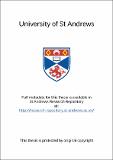Files in this item
The carbonylation of ammonia to urea
Item metadata
| dc.contributor.advisor | Cole-Hamilton, D. J. (David John) | en |
| dc.contributor.advisor | Pratt, Allin | en |
| dc.contributor.author | Butler, David Charles Donnell | en |
| dc.coverage.spatial | 236p | en |
| dc.date.accessioned | 2021-04-08T09:04:24Z | |
| dc.date.available | 2021-04-08T09:04:24Z | |
| dc.date.issued | 1997 | |
| dc.identifier.uri | https://hdl.handle.net/10023/22034 | |
| dc.description.abstract | Present industrial production of urea involves high temperature/ high pressure conversion of NH₃ and CO₂ via carbamate. There would be economic interest in a low-cost method for the manufacture of urea. One possible way of achieving this is by conversion of NH₃ and CO to urea with elimination of H₂, or H₂O. Although the thermodynamics of such a process are favourable, the reaction does not occur in the absence of catalyst due to the high energy barrier of activation. From what is already known about species which can lower this energy barrier, a mechanistic strategy has been devised to screen complexes which are active for the Water Gas Shift Reaction (WGSR) under basic conditions. [M(CO)₆] (M = Cr, W), [Fe(CO)₅], K[Ru(HEDTA)Cl].2H₂O and [RhH(PR₃)₃] (R = PEt, PᶦPr) are known WGSR catalysts which do not catalyse the carbonylation of NH₃ to urea under conditions for which they are active for the WGSR, however, [Ru₃(CO)₁₂] is active for this reaction with methanol or ethanol as solvent. Conditions for optimum activity are T = 160°C CO charging pressure = 2-10 bar and [NH₃] = ca. 7 mol dm^-3. ¹H NMR, IR and electrospray mass spectroscopy were employed for carbonyl cluster identification, and species found to be present after catalysis include [HRu₃(CO)₁₁]⁻, [H₃ Ru₄(CO)₁₂]⁻, [H₂RU₄(CO)₁₂]²⁻, [Ru6C(CO)₁6]²⁻, [Ru6(CO)₁₈]²⁻, [Ru₄(CO)₁3]2 , [H₂Ru₃(NH)(CO)₉], [H₃ Ru₄(NH₂)(CO)₁₂], and some unidentified Ru₇ and Ru₈ monoanionic cluster species. [HRu₃(CO)₁₁]⁻ appears to be the most abundant species present in solution, both before, during (identified by high pressure IR spectroscopy), and after catalysis. Additionally, [HRu₃(CO)₁₁][NEt₄] catalyses the reaction as a starting material and so is thought to be the catalytic intermediate in the reaction with [Ru₃(CO)₁₂] as precursor. The period of catalytic activity is short. Possible reasons for this include incorporation of NH₃ into formamide (effectively reducing [NH₃]), and the formation of a non-catalytic species, possibly a dianion such as [Ru₃(CO)n]²⁻, [Ru6C(CO)16]²⁻, or [H₂Ru₄(CO)₁₂]²⁻. V [RhHCl₂(PᶦPr₃)²] reacts with sodium amalgam in THF solution with trace H₂0 to form [RhH₂Cl(PᶦPr₃)²], which we have isolated. The crystal structure of a new polymorph of this complex is described. [RhH₂Cl(PᶦPr₃)²] can be used as an alternative route to make [RhH(PᶦPr₃)³], by the reaction with strong base in excess PᶦPr₃. [RhCl3.xH₂0] reacts with excess PᶦPr₃ in THF and in the presence of H₂0 under reflux to give [RhHCl3(PᶦPr₃)²][H PᶦPr₃], the crystal structure of which is described. In solution, at room temperature, it dissociates to [RhHCl₂(PᶦPr₃)²] and [CLH PᶦPr₃], and, on cooling, [RhHCl3(PᶦPr₃)²][H PᶦPr₃] can be observed in the 31P and low-field 'H NMR spectra. [RhH(PᶦPr₃)³] and [RhH₂Cl(PᶦPr₃)²] both react with NH₃ in THF solution to yield an unknown adduct thought to be [RhH₂(NH₂)(PᶦPr₃)²], Reaction with NH₃ is unprecedented for any complex of Rh and has possible mechanistic significance in the carbonylation of NH₃ to urea. | en |
| dc.language.iso | en | en |
| dc.publisher | University of St Andrews | en |
| dc.subject.lcc | QD315.B9 | |
| dc.subject.lcsh | Urea | en |
| dc.subject.lcsh | Ammonia. | en |
| dc.title | The carbonylation of ammonia to urea | en |
| dc.type | Thesis | en |
| dc.type.qualificationlevel | Doctoral | en |
| dc.type.qualificationname | PhD Doctor of Philosopy | en |
| dc.publisher.institution | The University of St Andrews | en |
This item appears in the following Collection(s)
Items in the St Andrews Research Repository are protected by copyright, with all rights reserved, unless otherwise indicated.

